
Syrian Arab Republic
Syrian Arab Republic, Grade 3 Emergency
- People in need: 15.3 million
- People targeted: 12.7 million
- People in need of health assistance: 12.2 million
- Requirements (US$): 88.3 million
Context
In 2022, health needs in Syria increased and more than 15 million people are now estimated to be in need of lifesaving and life-sustaining health services. The already heavily disrupted health system in the country has been further impacted by COVID-19, the global economic downturn and resulting decreases in humanitarian support, as well as the effects of international sanctions.
There are 4.4 million people residing in northwest Syria, with roughly two-thirds (2.8 million people) being internally displaced persons (IDPs). A large proportion of this population has fled multiple times since the start of the conflict and 1.7 million are living in tent encampments that are prone to flooding and are exposed to frigid temperatures during the winter. An over-stretched health workforce, combined with just 58% of hospitals and 53% of primary health care (PHC) centers fully functional, has left increasing numbers of people struggling to access health services, medicines and medical supplies. Poorly functioning water and electrical networks have further hindered health security in the country.
In addition, 2022 has seen the emergence of measles, meningitis and cholera outbreaks and the risk for further disease outbreaks remains high, particularly in areas where health system functionality is very low, such as Idlib and Aleppo in the northwest and Ar-Raqqa, Deir Ez-Zor and Al-Hasakeh in the northeast. Health system preparedness for future emergencies remains a challenge in this protracted crisis.
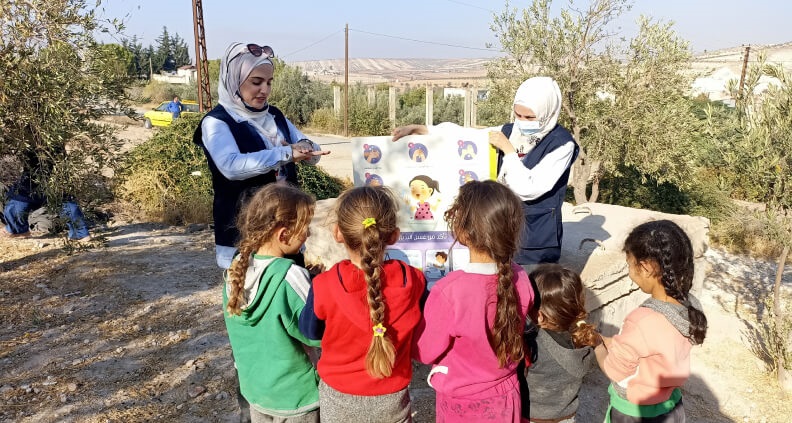
WHO staff disseminating messages on healthy practices and hygiene measures to control the cholera outbreak and curb the spread of the disease.
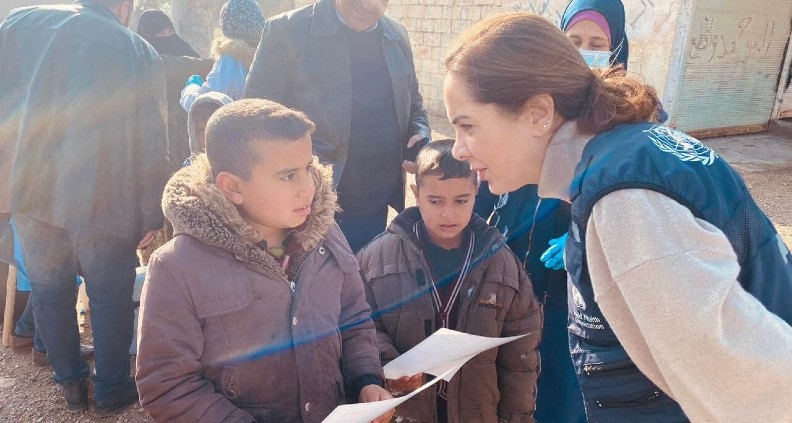
WHO Representative a.i. in Syria taking part in the OCV campaign in Deir-ez-Zor.
Emergency response
In 2023, as communicable diseases and household level vulnerabilities are increasing, it is critical to ensure investments in health service delivery are not lost due to resource shortages. Surveillance systems and essential primary and secondary health care services will be maintained to avoid enhanced mortality and morbidity. This includes sexual and reproductive health and safe delivery, child health, routine and expanded immunization, care for communicable and non-communicable diseases, mental health and psychosocial support. In northwest Syria, health facilities serve as critical entry points for essential humanitarian lifesaving primary health services, coordinated referrals to secondary care and trauma services and specialized care. Community outreach and engagement on integrated health messages will remain an essential component of comprehensive health services.
To avoid disruptions to the health response, critical support functions such as electricity, fuel supply, waste management and access to water must be ensured, particularly in the face of socio-economic upheaval. Access to essential medicines and medical supplies, including laboratory and testing materials will be ensured and supply chains strengthened using all modalities.
Surveillance, detection and response capacity for all diseases of epidemic potential remain key for public health security and necessarily include community event-based surveillance. COVID-19 vaccination coverage will be expanded, accompanied by strengthened community mobilization and awareness to promote vaccine uptake and continued adherence to public health measures. The ongoing cholera response, initiated in August 2022, will be further strengthened through multi-sectoral action to prevent and control the disease’s spread within the country and across its borders.
The health system’s resilience and early recovery capacities will also be enhanced, by focusing on building preparedness and response capacities, addressing health inequity and ensuring access for at-risk populations. Greater attention will be paid to addressing chronic systemic challenges, including shortages in human resources for health. This could be done by enabling pre-service and in-service training, supporting a holistic revitalization of health facilities, promoting technological solutions and better data and information systems to monitor health outcomes and plan for future needs, and expanding local and community partnerships to ensure an inclusive, whole-of-society approach to health system recovery. In addition, the protection of health care and the provision of mental health and psychosocial support for health workers will remain a critical priority.
Strategic objectives
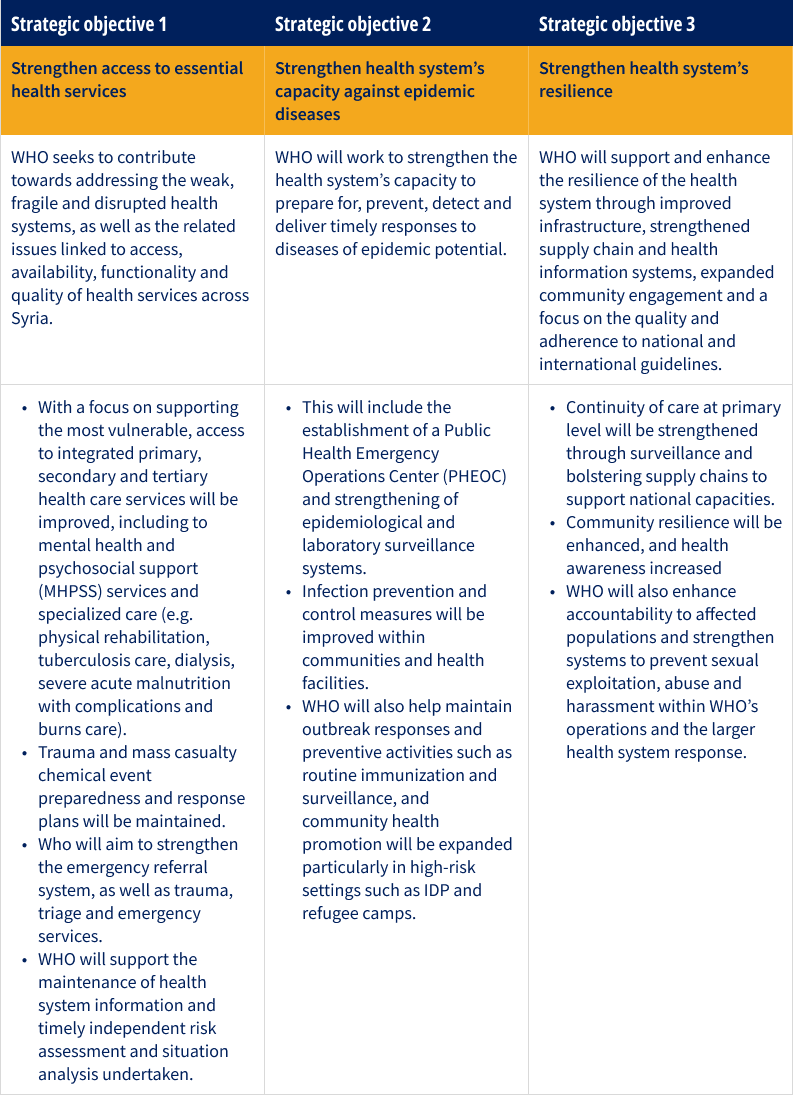

Key activities
- Maintain the health sector’s leadership and coordination and liaison with other sectors.
- Support information management, data collection and analysis together with reporting on health risks, needs, gaps and performance of the response.
- Provide technical expertise, promote evidence-based guidelines and capacity development of health professionals and support human resources.
- Maintain and strengthen essential health services, with a focus on those most vulnerable and in need.
- Strengthen the health system’s capacity to prevent, detect and respond to diseases of epidemic potential.
- Continue to support and coordinate ongoing outbreak response for COVID-19, cholera and measles and maintain the update of multi-hazards preparedness and response plan for northwest Syria.
- Ensure the rehabilitation of health services and structures.
- Drive health system quality through advocacy, policy and capacity-building.
- Improve risk communication and community engagement.
- Ensure the gradual transfer of health services delivery in northwest Syria to international NGOs and prepare for WHO’s phasing out, while still ensuring WHO’s ability to provide selected services as a last resort. This activity will be undertaken to mitigate the potential non-renewal in January 2023 of UN Security Council resolution (UNSCR) 2165, under which WHO has been providing cross-border assistance in northwest Syria. UNSC 2165 has been continuously renewed since 2014, although with some modifications.
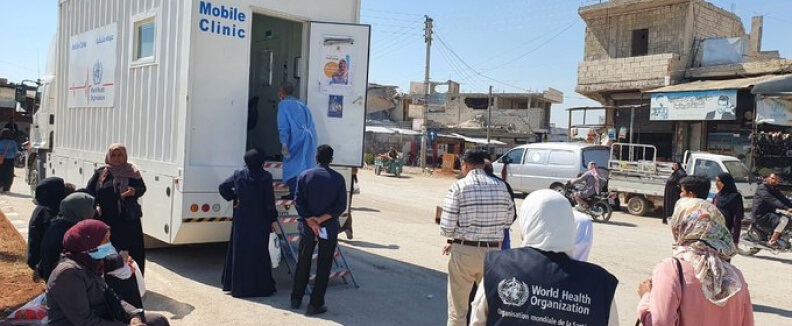
War has degraded the health system in the Syrian Arab Republic, and mobile clinics are a vital source of health services. The clinics circulate in Aleppo, rural Damascus and Deir-ez-Zor governorates.
Funding requirements
Overall country funding requirements, including COVID-19, by pillar (US $ ‘000)
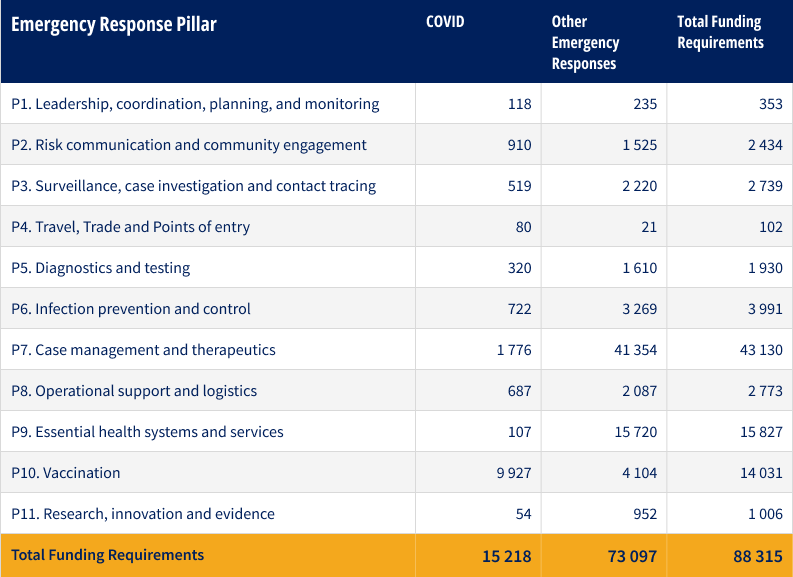

Success stories
Protecting the lives of displaced people with urgent health needs
Saber, a 9-year-old boy from Deir-ez-Zor governorate, is the only son of a vulnerable family that was forced to leave its village in search of security and shelter. The family was displaced multiple times until it ended up in the Areesha camp in northeast Syria.
“We used to live in a tattered tent under harsh weather conditions. We walked through the desert in the heat with no food for days on end. We experienced a lot of pain, hunger, fear and displacement until we finally settled in the Areesha camp,” Saber’s mother recounted. “A few months after Saber’s birth, he had been diagnosed with a brain cyst requiring surgery – an expensive procedure which we couldn’t afford,” the mother added.
In the camp, Saber’s health deteriorated a little more each day. He began suffering visual impairments and severe headaches. Following examination by a mobile medical team, Saber was referred to the WHO-supported Al-Hikmeh Hospital in Al-Hassakeh where he was admitted and started his treatment journey. Saber underwent surgery and received the needed medical interventions; his health improved gradually until he was discharged from the hospital and fully recovered.
For more information
Dr Iman SHANKITI | WHO Representative in Syria | shankitii@who.int
Dr. Idris Elrasheed | WHO Field Office, Gaziantep | idrise@who.int

